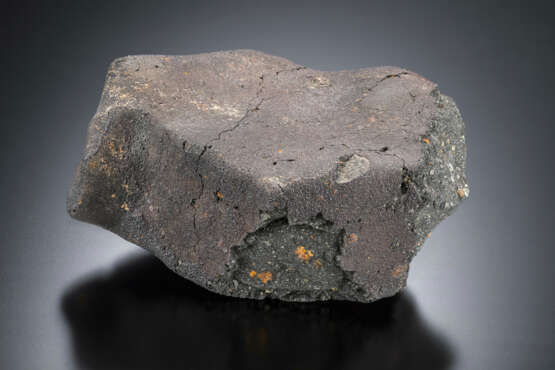ID 737490
Lot 1 | MURCHISON METEORITE — 7-BILLION-YEAR-OLD STARDUST
Valeur estimée
£ 15 000 – 25 000
Containing tens of thousands of organic compounds and perhaps related to the meteorites that introduced precursors of life to Earth, now offered is a pristine, exemplary specimen of what is among the most storied meteorites in the scientific literature. On January 13, 2020 the Murchison meteorite made headlines. Again. This time it was not the result of the 70-plus amino acids and tens of thousands of organic compounds it was previously found to contain. It was the announcement that a specimen of Murchison contained the oldest particulate matter ever encountered on our planet. A grain of stardust in a specimen of Murchison was determined to be more than seven billion years old — more than 50% older than the Earth and Sun.
In the morning of September 28, 1969 — the same year Apollo 11 landed on the Moon — a meteorite shower occurred over the town of Murchison, Australia. The labs that had been set-up to study Moon rocks were suddenly tasked with additional work when Murchison’s aromatic odor was plainly noticeable. We now know that Murchison meteorites contain a variety of organic compounds including alcohols, aromatic hydrocarbons, and fullerenes — the latter being a potential antiviral and anti-aging agent. And then there are its amino acids which can combine to form proteins — the building blocks of life. Murchison experienced chemical alteration by water-rich fluids on its parent asteroid prior to impacting Earth. Coveted by both scientists and collectors, the last several decades have seen specimens of Murchison becoming some of the most researched of meteorites with citations in scores of scientific papers. In 2010, an article in the Proceedings of the National Academy of Sciences announced that 14,000 unique molecular compounds were identified in a small section of a Murchison specimen. This study by a team of nine German scientists further determined that many of these organic compounds were present in the solar system before life commenced on Earth — which not only raises the question of whether meteorites played a key role in life's origins, but whether meteorites similar to Murchison may have seeded precursors of life in other solar systems as well.
Christie's would like to thank Dr. Alan E. Rubin at the Department of Earth, Planetary, and Space Sciences, University of California, Los Angeles for his assistance in preparing this catalogue.
55 mm x 40 mm x 27 mm (21/8 x 11/2 x 1 in.)
72g.
| Adresse de l'enchère |
CHRISTIE'S 8 King Street, St. James's SW1Y 6QT London Royaume-Uni | |
|---|---|---|
| Aperçu |
| |
| Téléphone | +44 (0)20 7839 9060 | |
| Commission | see on Website | |
| Conditions d'utilisation | Conditions d'utilisation |



